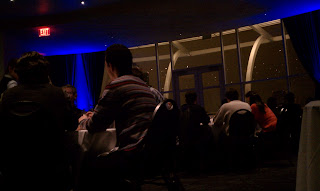Sorry for the lack of posts! I've been trying to get work done and prepare for the Gravitational-Wave Physics and Astronomy Workshop that I have just returned from. It was great getting to see Milwaukee (I was just sure to keep my mouth shut about being from Pittsburgh!). This is the first meeting of a new series that brings astronomers who are interested in gravitational waves together with physicists that are interested in the astronomy that can be extracted from them (gravitational waves, that is). When I give tours at LIGO, I often remark that there is very little difference between an astronomer and a physicist here since the goal of the research is to observe the universe in a new way. And that statement is by-and-large true. But the real difference between us is the detail of knowledge we know about particular things. Meetings like this are truly working on bridging that gap.
The day before the workshop began, there was a welcome reception at the Polaris restaurant at the top of the Hyatt Regency hotel (where most everyone attending the meeting stayed). I was thinking about blowing it off since I had been traveling all day, but was VERY glad I went since the restaurant was one of those slowly revolving ones that gave you a great view of the city. I'd never been to one before so it was a nice surprise. On top of that, there was wine, beer, Hors d'œuvres and good conversations with colleagues.
The next day started early with setting up the poster presentations (at larger meetings, scientific research posters are presented in place of talks - I plan a whole blog post about these posters soon!). The poster I brought was about the human vetting of candidate gravitational wave detections for optical follow-up (I wrote about this in a previous blog post). I was told where my poster would be displayed and when I would be giving my 1-minute "lightning talk" to advertise it. Below is my poster on display:
The day was then filled with presentations on various topics of interest. The major points were neutron stars, black holes, super nova, observational techniques, transient astronomy (that is where my poster on following-up on possible gravitational wave detections fit in) and tests of General Relativity. About 160 scientists attended this meeting. Below is a picture of about 75% of the meeting room showing a presentation in progress:
Want to know the real secret about meetings like this?... The real progress happens during coffee breaks and meals. This is the time that people can talk one-on-one and collaborate. For example, at the welcome reception (that I was thinking about blowing off), I ran into a friend of mine who is working on a book about gravitational wave astronomy. Through talking with him, I expressed interest in the book and now I will likely be giving it a proof/comment read. Then, at the banquet (more on that below), I ran into another colleague who is working on expanding LIGO's outreach to schools by working on a program that will bring scientists into classrooms via internet conferencing (like Skype). Since this is something I've been wanting to do for a while now, I am now working with them on this project. (If you are a teacher, and would be interested in having me Skype with your classroom, please contact me at amber@livingligo.org. There is also a program called "Skype in the Classroom" where you can sign up to participate collaboratively with other teachers.)
One of the things to really look forward to during the meeting is usually the conference banquet. This time, it was at Discovery World (a science museum). We were treated to a reception in the aquarium part of the facility followed by a very nice dinner. There is nothing neater than to have a good drink while getting to explore a museum (and touch sting rays). I took the picture below during dinner. It isn't the best picture and only shows a few people, but I took it and now you get to look at it :)
When the meeting wrapped up after 3.5 very full days, I was excited by the experience but tired and ready to go home. One of the best parts of the little down time I did have was the view from my hotel room. I was on the 11th floor of the Hyatt Regency and had a great view of downtown Milwaukee:
On a side note: this hotel was the location where then presidential candidate Theodore Roosevelt was shot while campaigning in 1912. (The hotel was then the Gilpatrick Hotel.) He then went on to deliver his campaign speech and mentioned more than a few times that he had been shot and that "it takes more than one bullet to kill a Bull Moose." The bullet entered his chest bust didn't damage his lungs since the bullet first passed through a steel eyeglass case and a 50 page draft of his speech. Since the bullet didn't pose a threat to his health, it was determined to be more dangerous to remove it than to leave it alone - he carried that bullet in his body for the rest of his life. (You can read more about it here.)




